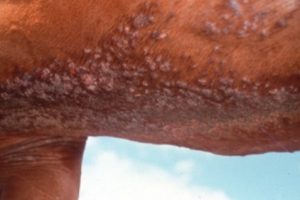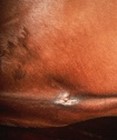3.15 Ventral Midline Dermatitis – Horses
Learning Objectives
- Know what causes ventral midline dermatitis in horses.
- Describe the lesions associated with this skin disease.
- Know the main differential diagnoses for ventral midline dermatitis.
- Learn how to manage ventral midline dermatitis.
-
General Considerations:
- Ventral midline dermatitis is a distinctive, frequently encountered, fly-related dermatosis of horses.
- The disease occurrence coincides with the peak of the fly season, first appearing in the spring and regressing in the fall.
- Horses over 4 years of age are most frequently affected.
-
Cause and Pathogenesis:
- The condition is caused by the bites of Haematobia (Lyperosia) irritans (the horn fly) and Culicoides spp. gnats.

-
Clinical Signs:
- The disease is limited to the ventral midline of the abdomen and thorax.
- The lesions consist of a few to several sharply demarcated areas of papules, nodules, punctate ulcers, hemorrhagic crusts, skin thickening, alopecia and leukoderma (i.e. skin depigmentation).


-
- The lesions vary from less than 1 inch up to 10 inches in diameter.
- The umbilical area is most commonly affected.

-
- The majority of horses on the premises are affected in contrast with insect bite hypersensitivity where typically only one horse is affected.
- Pruritus varies from severe to mild and may correspond to the presence or absence of a hypersensitivity reaction to fly salivary antigens in an individual horse.
-
Diagnosis:
- History, clinical signs and the presence of flies on the horses’ premises.
- Ventral midline dermatitis must be differentiated from cutaneous onchocerciasis and insect bite hypersensitivity.
-
Treatment:
- Gentle cleaning of affected areas with a mild soap to remove the crusts should be part of the treatment regimen.
- An antibiotic-corticosteroid ointment can be applied twice daily until healed.
- Frequent applications (2 to 3 times daily) of a fly repellant spray should be instituted. Products containing DEET and permethrin are generally effective. A product that has anecdotally shown good efficacy as fly repellent is Mosquito Halt® Repellent Spray for Horses (Farnam Companies, Inc.; Phoenix, AZ).
- The use of insecticides in ointment base (e.g. pyrethrin in Vaseline®) may also be used.
- A thick coat of Vaseline® provides a barrier against further fly bites and should be considered after the lesions have resolved.
- Systemic glucocorticoids for 2 to 3 days may be required in animals with severe pruritus.
- Control of horn flies is relatively easy as adult flies spend most of their life on the host (see “Flies” chapter).
- Separate cattle from horses.
- If Culicoides gnats are the main flies on the premises, consider stabling the horses at night when they are most active and use fans in the stable to blow away the gnats.
- Keep the environment clean of fresh manure and eliminate stagnant water.
Important Facts
- Ventral midline dermatitis is a common condition caused by the bites of horn flies and especially Culicoides spp. gnats.
- Lesions tend to concentrate around the umbilical area but any region along the ventral midline of the abdomen and thorax can be affected.
- Lesions consist of well-demarcated areas of thickened skin, scaling, alopecia, ulceration, crusts and leukoderma.
- Severely pruritic animals may have developed a hypersensitivity reaction to fly salivary antigens.
- Treatment involves cleaning the affected area(s); the application of topical ointments containing antibiotic and steroids and the frequent application of fly repellents.
References
Fadok VA. Ectoparasites. In: Robinson N.E., ed Current Therapy in Equine Medicine II. Philadelphia; W.B. Saunders, 1987:622.
McMullen WC. Equine dermatology. Proceedings-Annual Convention of the American Association of Equine Practitioners (USA) 1977.
Panel Report: Dermatologic problems in horses. Mod Vet Pract 1981; 62:75..
Scott DW. Large Animal Dermatology. 1st edn. Philadelphia: W.B. Saunders, 1988; 244.

